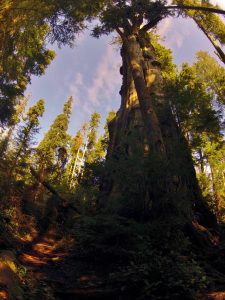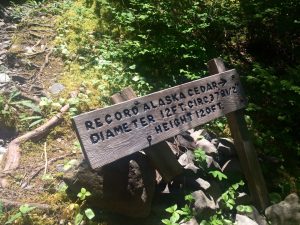The local trees built Grays Harbor. Looming large from the lush forests all around the region, towering trees rise above the ferns and moss below, bearing the brunt of the wind and rain along the Washington Coast.
Over the last 130 years or so, the majority of the huge hunks of wood were felled, building the nation and becoming a sense of pride for the locals. While today, many of the tallest of the timbers have been removed, there are a handful of massive stands of trees as well as a few individual giants that are worth exploring. From Montesano to the coast, and everywhere in-between, these are some of our favorite places to see the tallest and largest trees around.
We start at Lake Quinault where huge trees pepper the lush landscape. The most famous tall tree in the region is also the most accessible. Known as the Quinault Lake Sitka Spruce, this tree is a must-see while driving the Lake Quinault Loop. Mere minutes from the iconic Lake Quinault Lodge, you’ll find the World’s Largest Spruce Tree. With a height of 191 feet and a circumference of just under 59 feet, this tree is huge. Said to be roughly 1,000 years old, the Quinault Spruce has seen more than we can imagine. This tree should not be missed!

Elsewhere in the Quinault region, more towering trees holding records can be found. Near the sitka spruce, the co-largest Douglas fir in the world can be found, standing 302 feet tall. Located in the Quinault Research Natural Area, this tree is located off trail and isn’t easy to find. However, walking the Quinault Loop trails SE of South Shore Road will have you spotting runners up. Across the lake, July Creek Picnic area and trail also has some towering trees that you’ll be craning your neck to see the top. This is near the site of what used to be the world’s largest Western Red Cedar, which toppled down in 2016.
For those up for a hike, America’s largest yellow cedar can be found a few miles above Irely Lake, while America’s largest western hemlock can be witnessed in all its glory near the Enchanted Valley Chalet in the Quinault Rainforest. In that same region of Olympic National Park, the largest mountain hemlock in the world rests, though it is located off trail and can be tough to find. A rough map of these trees can be found here.
Not every massive tree in Grays Harbor is local. Out in eastern Grays Harbor, in the town of Montesano, there are a few trees that have the potential to become giants. Located at Fleet Park, six giant sequoia trees were planted in the 1940s. Today, the trees stand tall, but this is just the beginning for these wooden monsters. If they survive wind, wet ground, logging, and every other factor stacked against them, these trees could be massive, reaching up to 300 feet in height. They may also live to be thousands of years old, so enjoy them now as they will probably outlive any memory of us.

There are dozens of other locations to see impressive trees, but your best bet for undisturbed giant trees is Olympic National Park. However, for a unique – and mostly drivable – way to see some incredible stands of forests, we end with a classic route. For many, the trees found along Donkey Creek Road all the way to the Wynoochee Lake are special. With bridge crossings over Donkey Creek, the Humptulips and Wynoochee rivers, this trek follows old logging routes that have been used for more than 75 years. Keep in mind that along this seasonal road there aren’t numerous picnic or hiking trails – this is wild and wonderful. Crossing the southern end of the Olympic Peninsula, the dirt road weaves and meanders along waterways and through forests home to various woodland creatures. The road, drivable in the summer and early fall months, is known for bear sightings, deer and grouse constantly crossing the road, and sections of old growth forests. The drive is highlighted by the Campbell Tree Grove Campground, open from May to November. Here, you will find towering conifers including sitka spruce, Douglas fir, western hemlock and western red cedar, as well as a forest floor covered with lush rain forest plants.
While many of the region’s largest trees have been cut down ages ago, there are still giants lurking in the forests all around our homes. Some will fall during storms or give out from old age, but new trees are growing today, sure to replace their grandeur and stature over time. These will be the tall trees of the future. Now, with sustainable forests, we can let the existing old growth trees and newer ones continue to grow, giving us peace of mind that they will be around for the enjoyment of generations to come.